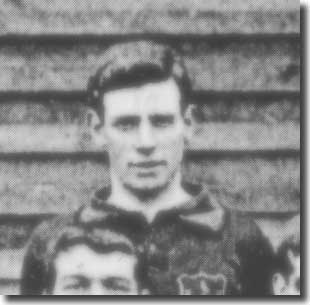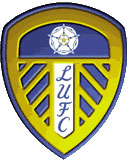 Born:
Bootle, Lancashire, 1882
Born:
Bootle, Lancashire, 1882
Charlie Morgan spent the early part of his career in reserve football.
He joined one of his local clubs, Everton, in 1903, but couldn't break
into the first-team picture and signed for Tottenham Hotspur of the Southern
League in May 1904. He suffered a broken jaw in pre-season for the Londoners
and spent much of the following campaign again in reserve team football.
Morgan signed for Leeds City in the 1905 close season as they sought
to build a side that could compete in the Second Division, and he was
given his debut in their first league
game, against Bradford City on 2 September. Leeds lost 2-1 but, according
to Linesman in the Leeds Mercury, Morgan 'hungered after the ball
in a manner calculated to put any wing man off his game'.
He was a mainstay of the side and did not miss a game until he was
out injured for the 4-0 defeat at Chelsea on March 31. Goalkeeper
Harry Bromage and outside-left Harry
Singleton were the only men who were able to better that opening
run. Morgan ended the season having
missed just three games and his one goal, in December against Bristol
City, was vital, securing a 1-1 draw.
He lost his place to Jack Morris at the
start of the 1906/07 season, before
former centre-forward Fred Hargraves settled
down to monopolise the right-half position. One disgruntled City follower,
'True Peacock', mused in a letter to a local paper, 'Where is Morgan,
the star performer of last season at half-back?' Secretary-manager Gilbert
Gillies responded with a testy assertion that Morgan was unavailable
through injury.
In December, the Leeds Mercury reported, 'We have received a host
of letters from correspondents on the subject of the Leeds City team,
which we are unable to find space for. They come from all quarters, and
go to show the enormous interest which is being taken in the club. Most
of the letters express surprise at the continued absence of Morgan. Morgan's
admirers will be glad to learn that it is only a question of health that
keeps him out of the half-back line, and he will probably make his reappearance
before the season is much older.'
When Morgan did return to the side for his third appearance of the campaign,
a home game with West Bromwich Albion on 5 January, according to Flaneur
in the Mercury, he received 'a very hearty reception from the crowd'
and 'justified everything that had been written of his abilities. He was
both dashing and resourceful, and defended cleverly while feeding his
forwards with judgement.'
Conversely, three weeks later, after the 4-1 Elland Road defeat to Nottingham
Forest, Linesman wrote in the same paper, 'Morgan's display was one of
the feeblest he has ever given at Elland Road. He did some clever things,
but he failed to show his usual energy ... It is true he was facing perhaps
the best left wing in the Second Division but he never during the game
suggested the form he displayed against West Bromwich. No doubt the fact
that Morgan is always playing for his place affects his play. It is quite
certain that on Saturday's form the Selection Committee will feel they
have some justification for their persistent neglect of him.'
Morgan managed just 6 appearances all season. Indeed, after the 1-1
draw at home to Blackpool on 2 February (his 41st League appearance
for the Peacocks), he never appeared again for City's senior team.
He remained at Elland Road for another couple of seasons before choosing
to rejoin former Leeds City boss Gilbert Gillies at Bradford Park Avenue.
He appeared once in the league for Bradford before moving on to Halifax
Town, where he ended his playing days.
After Leeds City's expulsion from the League in 1919, Morgan was one
of seven men elected as the first management committee of the newly
formed Leeds United, along with Alf Masser, Joe Henry junior, Mark Barker,
R E H Ramsden, Charles Snape and former team mate, Dick
Ray.











 Born:
Bootle, Lancashire, 1882
Born:
Bootle, Lancashire, 1882